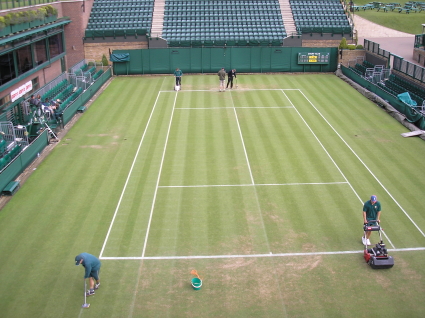The All England Lawn Tennis & Croquet Club is testing hybrid grass tennis courts to recreate the surface in different climates as well as to extend the playing season in the UK.
The trials are currently taking place at the All England Lawn Tennis & Croquet Club Raynes Park grounds two miles away from the Wimbledon tournament venues. Hybrid grass surfaces are popular in football and rugby as the synthetic turf fibres strengthen the top-layer of the surface thus preventing chunks of grass to be ripped out of the field by players sliding over the field. The fibres also contribute by the picture to fans in the stands and on TV as they ensure that the field always looks lush and green.
Exporting tennis on grass
According to Neil Stubley, Wimbledon’s head of courts and horticulture, stitching synthetic turf in the sandier soils for grass tennis surfaces helps make the structure of the playing surface more stable and resilient. ““One of the biggest challenges for grass tennis is that you need quite a heavy clay soil because what you need to do is be able to dry it out and get the ball bounce. So you can actually have a more free-draining surface but you can still get the hardness on the surface as well. You can then go to a place like Australia and create good grass courts,” he said.
He admitted that Wimbledon’s clay soil is ideal for grass courts, but that other parts of the world are dominated by sand or chalk. Stubley said using grass-stitching with sandier soils helps make the structure of the playing surface more stable and resilient.
First tennis court stitched
Wimbledon began trials with the Sports Turf Research Institute on small plots of grass at its Yorkshire headquarters in 2016. The club began building the hybrid courts at Raynes Park in 2020 and they have been played on since 2021. The hybrid court is 95% real grass with the additional plastic fibre reinforcement. “We’ve been researching for three or four years but at the moment it’s going well. We’ve got some trial courts now and we’re just getting players and members to play on it and feed back,” Stubley said.
“We’re doing a lot of research in southern hemisphere grasses, Bermuda grasses and the like, so we can actually end up having a product where we can have the right root zone and the right grasses on top to give us the same characteristics of a court at Wimbledon.”
The Sports Turf Research Institute tests the surface on hardness, ball bounce, ball height and speed of the ball coming through.
Not at Wimbledon anytime soon
Despite all progress made, the Wimbledon’s head of courts and horticulture doesn’t expect hybrid surfaces to be used at the Wimbledon tournament any time soon. “The stitch system probably for the betterment of world grass-court tennis,” he said. “I think the Championships are a standalone. We kind of get to the point where we can have better-quality courts around the world. It’s more about getting juniors more used to grass so it’s not so alien to them when they come on the main tour.”
Nevertheless, Wimbledon itself, which from this year permanently loses its middle Sunday rest day, meaning more constant wear and tear, has benefited from technological advances over the years.
This has included painstakingly trialling and selecting the best type of ryegrass and a better understanding of the use of nutrients and chemicals. Steam-sterilising the courts at high temperatures helps control weeds, pests and fungi, meaning there is less reliance on fungicides.
“It’s just a combination of those sorts of things that’s put us in a position now where we just feel confident that that extra day won’t have a direct impact on the quality of the turf,” he said.


